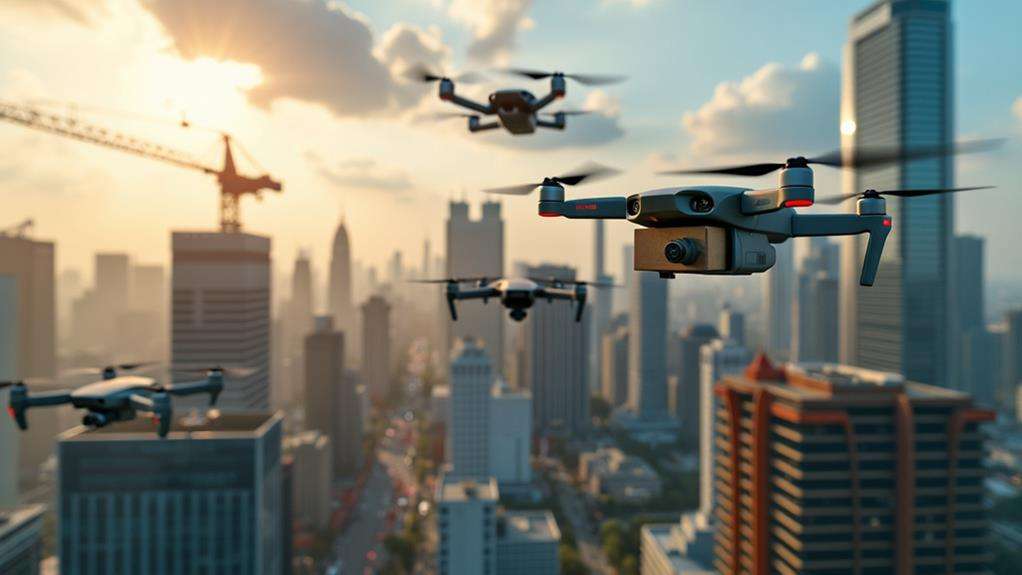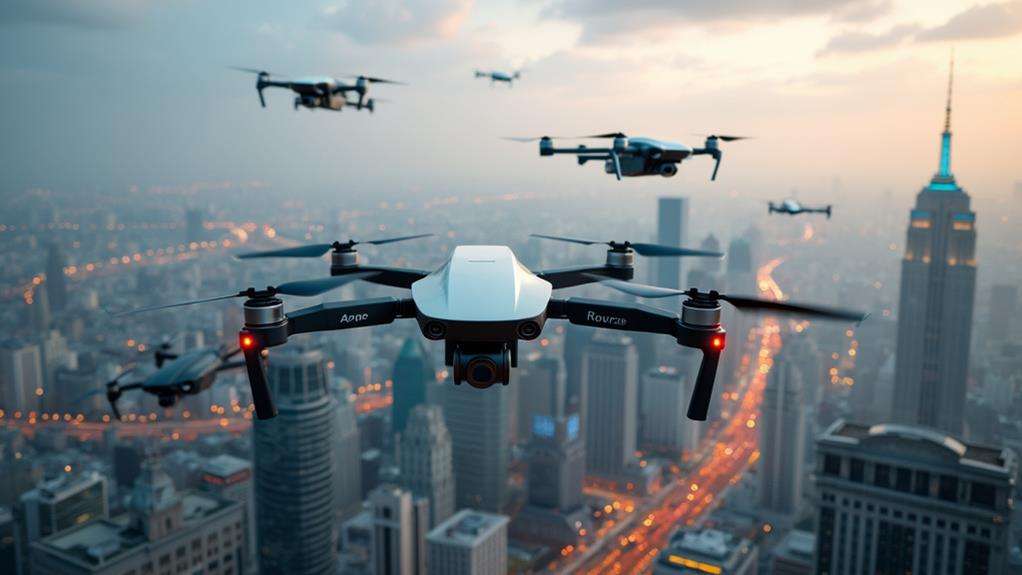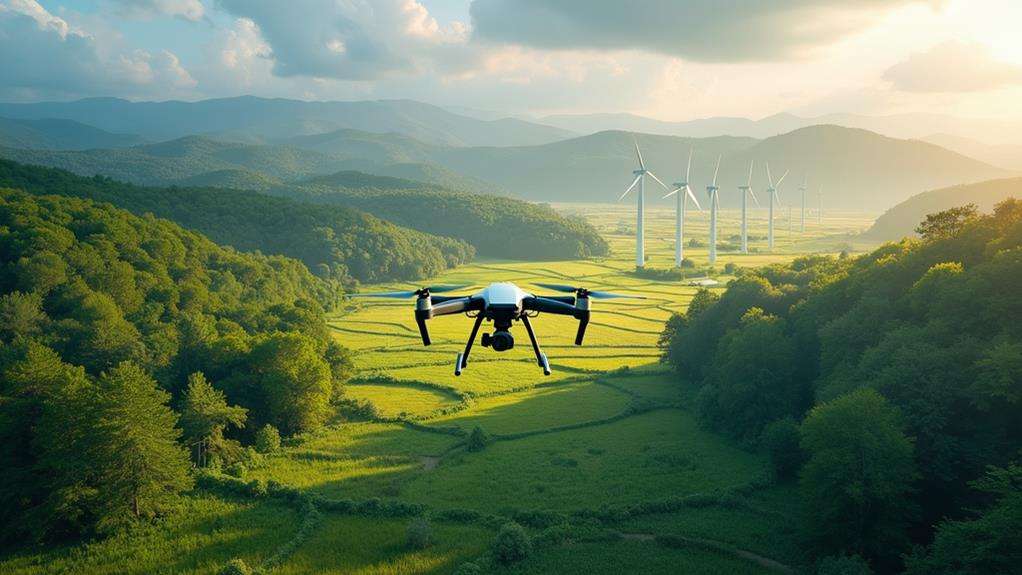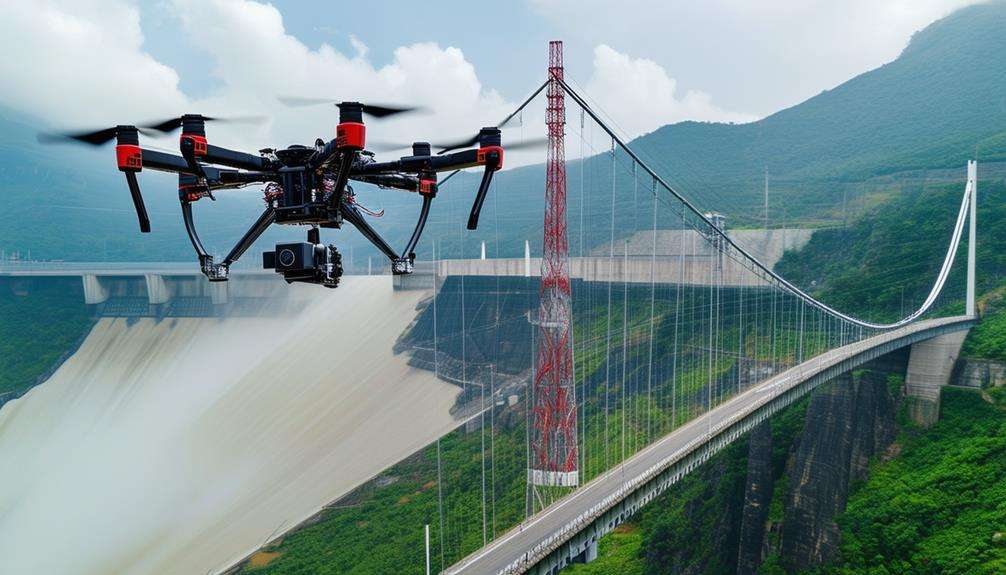The Economic Impact of UAVs: How Drones Are Creating New Business Opportunities

The rise of UAVs is revolutionizing various industries by creating new business opportunities. The commercial drone market is projected to reach $63.6 billion by 2025, benefiting sectors such as logistics, agriculture, and aerial photography through enhanced efficiency and innovative solutions. Precision farming can now maximize crop yields, while real-time data collection optimizes delivery routes. Beyond convenience, these advancements promise significant job creation and economic growth. How are these technological developments shaping the future, and what challenges do they pose?
Definition and Overview of Drones
In recent years, drones, also known as unmanned aerial vehicles (UAVs), have gained widespread popularity for their versatility and efficiency. Initially developed as safer alternatives to manned military aircraft, drones have become integral to modern technology. They can be controlled remotely or operate autonomously, utilizing key components such as batteries, microcontrollers, motors, and various sensors.
Commercially, drones are revolutionizing industries from agriculture to aerial photography, with a significant economic impact. The global commercial drone market was valued at approximately $1.6 billion in 2022 and is projected to reach nearly $1.8 billion by 2023. This growth highlights the diverse business opportunities drones present.
Technological advancements, including autonomous operation and swarm intelligence, are enhancing data collection and operational efficiency. These innovations streamline existing processes and open new economic opportunities. With a total addressable market estimated at $127 billion globally, drones are poised to play a crucial role in shaping the future of various sectors.
Market Size and Growth Potential
You are about to delve into the flourishing commercial drone market, which expanded from $1.6 billion in 2022 to nearly $1.8 billion in 2023. Key applications such as aerial photography, which accounts for 34% of the market, and agricultural drones, growing at a Compound Annual Growth Rate (CAGR) of 22.94%, underscore the broad range of investment opportunities. With drone registrations in the U.S. surging, it is evident that Unmanned Aerial Vehicle (UAV) technology is being rapidly integrated across numerous sectors.
Projected Market Growth
The commercial drone market is experiencing robust growth, showing a strong upward trajectory. Valued at $1.6 billion in 2022, it is projected to reach nearly $1.8 billion by 2023. This steady increase underscores the rising demand for drone services and the sector's vast potential for innovation and job creation.
Consider these compelling statistics:
- The market is expected to grow by $44.85 billion from 2022 to 2027, with a CAGR of 38.97%.
- The Federal Aviation Administration (FAA) projects over 352,200 commercial drones in the U.S. by 2023, up from 42,000 in 2017.
- Aerial photography and videography account for 34% of commercial drone services.
- Agricultural drones are anticipated to grow at a CAGR of 22.94% from 2022 to 2028.
Technological advancements, particularly in delivery services and other innovative applications, are driving this growth. With a total addressable market estimated at $127 billion globally, the commercial drone market's expansion offers significant opportunities. The adoption of these technologies can transform industries, create new jobs, and redefine business operations in the future.
Key Industry Applications
Commercial drones have established essential roles across various industries, demonstrating their versatility and significant growth potential. In 2022, the global commercial drone market was valued at approximately $1.6 billion, with projections indicating it will nearly reach $1.8 billion by 2023. This upward trend underscores the expanding opportunities within the drone sector.
One notable application is drone delivery, which is transforming the logistics industry by providing faster and more efficient delivery solutions. In agriculture, drones are making a substantial impact, boasting a remarkable CAGR of 22.94% from 2022 to 2028. These agricultural drones facilitate precision farming by enabling farmers to monitor crops, manage resources, and enhance yields effectively.
The aerial photography and videography market is another significant segment, accounting for around 34% of commercial drone services. This demonstrates a robust demand from the creative industry for high-quality aerial imagery.
Service providers in the drone industry are positioned for considerable growth. The overall commercial drone market is projected to expand by USD 44.85 billion from 2022 to 2027. Additionally, the number of commercial drones in the U.S. is expected to surge from 42,000 in 2017 to over 352,200 by 2023, highlighting the increasing market opportunities.
Investment Trends Analysis
The commercial drone market is experiencing significant investment interest due to rapid technological advancements and expanding use cases. The global total addressable market for commercial drone applications is estimated at $127 billion. Projections indicate that the drone market could reach $100 billion between 2016 and 2020, showcasing its immense potential and opportunities for investors.
Key factors driving these investment trends include:
- The commercial drone market was valued at $1.6 billion in 2022 and is expected to grow to nearly $1.8 billion by 2023.
- The market is forecasted to increase by $44.85 billion from 2022 to 2027, with a compound annual growth rate (CAGR) of 38.97%.
- Commercial drone sales surged from 110,000 units in 2016 to around 170,000 units in 2017, marking a 60% growth.
- The industrial drone fleet in Europe and the US is projected to grow to 1 million units by 2050, with a market value of $50 billion.
This growth is not only reflected in market numbers but also in technological innovation and job creation. With total drone investments since 2012 reaching approximately $1.5 billion, the sector's future appears promising.
Commercial Applications of Drones

Leveraging drones for commercial purposes is revolutionizing various industries by boosting efficiency and precision. From enhancing logistics with delivery drones to streamlining data collection in agriculture and construction with UAS technology, drones are transforming business operations. By adopting drones, businesses can significantly cut costs and improve accuracy.
Aerial photography and videography dominate the sector, accounting for around 34% of commercial drone services. These applications provide stunning visuals invaluable for marketing, real estate, and entertainment. Meanwhile, agricultural drones are rapidly growing, with a CAGR of 22.94% from 2022 to 2028, offering farmers precision monitoring and data collection capabilities to optimize crop management.
The construction and surveying industries also benefit from drones, which provide real-time data and high-resolution imagery, leading to better decision-making and operational efficiency. This integration has created job opportunities, with over 331,570 individuals obtaining Remote Pilot Certificates by late 2023 to meet the demand for certified drone pilots.
Additionally, delivery drones are becoming increasingly common, with over 2,000 drone deliveries completed daily as of early 2022. This trend underscores the growing adoption of drones in logistics, making the future of drones in business incredibly promising.
Investment Trends in the Drone Industry
The drone industry has attracted significant investment, totaling approximately $1.5 billion since 2012. Investment hotspots include China, Israel, and the US, highlighting the global scale of the drone market. In 2017, 52 investment deals injected $216 million into the sector, with 62% of these deals comprising seed and Series A funding.
Investors are increasingly focusing on the commercial drone market, which is projected to reach a value of $63.6 billion by 2025. This growth is driven by several key factors:
- Technological advancements fueling innovation
- Expanding applications in sectors such as agriculture, logistics, and surveillance
- Rising consumer demand for both recreational and professional drones
- Regulatory developments promoting wider adoption
While early-stage investments dominate the current landscape, the sector has seen limited exits or IPOs. However, consolidation is anticipated, particularly through mergers and acquisitions in the commercial market. Major players like DJI command significant shares in the consumer market, while US companies are establishing strong positions in commercial hardware and analytics.
As the global drone market continues to evolve, staying informed about these investment trends will be essential for capitalizing on the industry's growth opportunities.
Major Players in Drone Delivery

The drone delivery market is rapidly evolving, with major players making significant advancements. Amazon has initiated drone delivery operations in College Station, TX, and Lockeford, CA, aiming to handle a substantial portion of their 1.6 million daily package deliveries via drones. This ambitious plan underscores Amazon's commitment to integrating drone technology into their logistics network.
Alphabet's Wing is another key player, actively testing drone delivery services in Logan, Australia. They aim to complete millions of deliveries by mid-2024. In the U.S., Wing has partnered with Walmart for local deliveries in the Dallas-Fort Worth area, showcasing their versatility and extensive reach.
FedEx is also advancing in this space, collaborating with Elroy Air to test the Chaparral aircraft, designed for transporting heavy cargo. This partnership highlights the potential for drone delivery to extend beyond lightweight packages, opening new logistics opportunities.
DoorDash is exploring drone delivery by conducting trials in Queensland, Australia, using Wing's technology. This initiative reflects the growing interest among food delivery services in adopting drone logistics, indicating a broadening scope for drone applications.
Each of these companies is pushing the boundaries of drone delivery, demonstrating the technology's expanding capabilities and potential.
Regulatory Challenges
When considering the economic impact of UAVs, the evolving FAA regulations are crucial. Stringent rules on visual observation and the new Remote ID requirements aim to enhance safety and privacy but also pose significant challenges for operators. Navigating these regulations is essential for unlocking the full market potential of commercial drone services.
Evolving FAA Regulations
Navigating the evolving landscape of FAA regulations presents significant challenges for commercial drone operators. As the use of unmanned aerial vehicles (UAVs) continues to grow, staying current with the latest rules can be daunting. The FAA projects that commercial drone usage in the U.S. will skyrocket from 42,000 in 2017 to over 352,200 by 2023. This exponential growth makes compliance an ever-moving target.
Recent FAA rule changes now permit drones to operate over populated areas and at night, given prior notification. However, fully autonomous operations remain heavily restricted, adding another layer of complexity for drone operators. Additionally, the FAA is collaborating with NASA to develop a low-level air traffic management system, a project expected to take years, further complicating the commercial use of UAVs.
Key points to consider:
- Commercial drone usage in the U.S. is projected to increase drastically.
- New FAA rules allow night operations and flights over populated areas under specific conditions.
- The development of a low-level air traffic management system is ongoing.
- Over 331,570 Remote Pilot Certificates have been issued, reflecting growing compliance needs.
Furthermore, over 44 states have enacted their own regulations, creating a complex web of compliance requirements that drone operators must navigate.
Safety and Privacy Concerns
As FAA regulations evolve, safety and privacy concerns have come to the forefront of the UAV industry's regulatory challenges. Many worry about how drones' data-collection abilities could intrude on personal privacy. These concerns have led 44 states to enact their own laws regulating drone usage, creating a fragmented regulatory landscape across the U.S.
For commercial drone services, navigating these regulations can be a significant hurdle. The FAA mandates that drones be directly observed by a flight controller, complicating autonomous operations. This restriction can limit the efficiency and scalability of drone-based services. However, recent FAA rule changes now permit drones to operate over populated areas and at night, provided strict safety standards are met and prior notification is given.
Compliance with evolving regulations, such as remote ID requirements, is crucial. These rules ensure drones can be identified and tracked, which is essential for maintaining operational legitimacy and safety within the industry. Whether running a commercial drone service or simply an enthusiast, staying updated on these regulations is critical for avoiding legal issues and protecting public trust.
Technological Advancements

Technological advancements in UAVs are revolutionizing the industry by driving significant improvements in performance and capabilities, making drones more efficient, versatile, and safer. These innovations are unlocking new potential for their application across various sectors.
- Battery Technology: Innovations are extending flight times, allowing drones to operate longer without frequent recharging.
- Artificial Intelligence: AI is enhancing autonomous navigation and obstacle avoidance, leading to safer and more efficient operations.
- Advanced Sensors: New sensors improve data collection and analysis, benefiting sectors like agriculture and infrastructure monitoring.
- Miniaturization: Smaller, more efficient components enable drones to perform complex tasks in tighter spaces.
By leveraging these technological advancements, drones are becoming indispensable tools across industries. Improved data collection through advanced sensors enables precise agricultural practices and meticulous infrastructure inspections. Enhanced autonomous navigation, powered by AI, ensures drones can safely navigate complex environments, reducing the risk of accidents.
In emergency response scenarios, drones equipped with these cutting-edge technologies can provide rapid assessment and aid delivery, significantly improving disaster relief efforts. As drone technology evolves, expect more innovative applications, creating new business opportunities and transforming traditional practices in numerous fields.
Economic Impact of Drones
The economic impact of drones is undeniably profound, reshaping various industries and driving substantial growth. The global commercial drone market, valued at nearly $20 billion in 2022, is projected to grow at a CAGR of 13.9% through 2030, highlighting its significant economic potential.
| Impact Area | Economic Contribution | Job Creation |
|---|---|---|
| National Airspace | $13.6 billion | 34,000 |
| U.S. Drone Industry | $13.6 billion | 100,000 |
| Global UAV Market | $58.4 billion | N/A |
These figures represent real opportunities for job creation and economic growth across various sectors such as manufacturing, delivery services, and military applications. The integration of drones into the National Airspace System (NAS) is expected to create over 34,000 manufacturing jobs in the initial phase. By 2030, job creation in the U.S. drone industry is projected to exceed 100,000, with average salaries around $40,000, underscoring the sector's role in workforce development.
Drones are also enhancing operational efficiencies in sectors like agriculture, contributing approximately $13.6 billion to the U.S. economy through precision farming techniques. The global UAV market is expected to reach $58.4 billion by 2026, driven by increased demand in agriculture, logistics, and military spending.
The economic impact of drones is vast, offering substantial opportunities for growth and innovation in multiple industries.
Environmental Benefits

In addition to their transformative economic advantages, drones are making significant strides in environmental sustainability. By replacing traditional vehicles in delivery services, drones substantially reduce carbon emissions, contributing to a greener planet.
In agriculture, drones facilitate precision farming techniques that optimize resource use. For example, they can decrease pesticide application by up to 90%, resulting in a much lower environmental impact. This not only conserves resources but also promotes healthier ecosystems.
Drones are also crucial in wildlife conservation efforts. They enable the monitoring of endangered species and their habitats without causing human disturbance, ensuring that these fragile ecosystems remain protected.
Furthermore, drones play an essential role in disaster management. They can swiftly assess damage and monitor environmental changes, providing timely data that aids in recovery and mitigation efforts. This rapid response capability is vital for minimizing the long-term environmental impact of natural disasters.
- Precision farming: Optimize resource use and significantly reduce pesticide application.
- Wildlife conservation: Monitor endangered species with minimal human disturbance.
- Disaster management: Provide timely data for effective recovery and mitigation.
- Carbon reduction: Lower emissions in delivery services.
Privacy Concerns and Disadvantages
Concerns about the privacy implications of drone technology are on the rise. Drones equipped with cameras and GPS can collect data that feels intrusive, raising worries about surveillance of private or public spaces without consent.
To address these concerns, 44 states have enacted laws regulating drone usage. These regulations aim to mitigate privacy and surveillance issues associated with drones. Advanced imaging technology, facial recognition software, and motion sensors on drones can enhance surveillance capabilities, heightening public apprehension about unauthorized data collection and privacy breaches.
In densely populated urban areas, the potential for unintentional privacy violations is even higher due to the complexities of drone delivery operations. For instance, a drone might accidentally fly over your backyard or peer into your window, which can be unsettling.
Although regulations exist to address these issues, the rapid advancement of drone technology often outpaces legal frameworks, making many feel vulnerable. As drones become more prevalent, it is crucial to balance their benefits with robust privacy protections.




